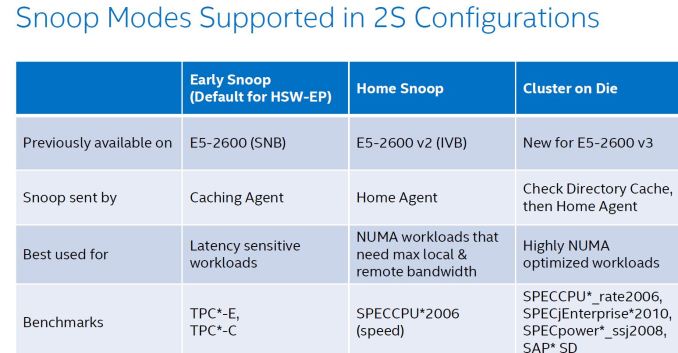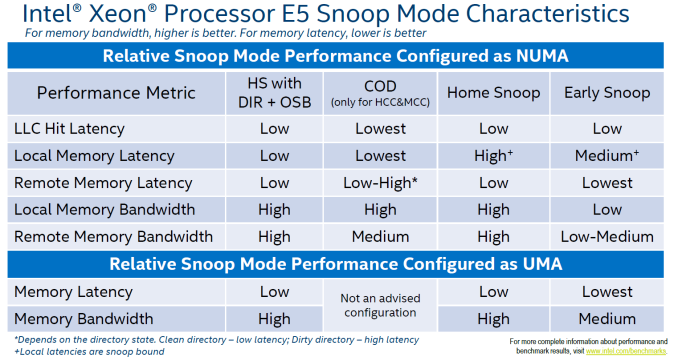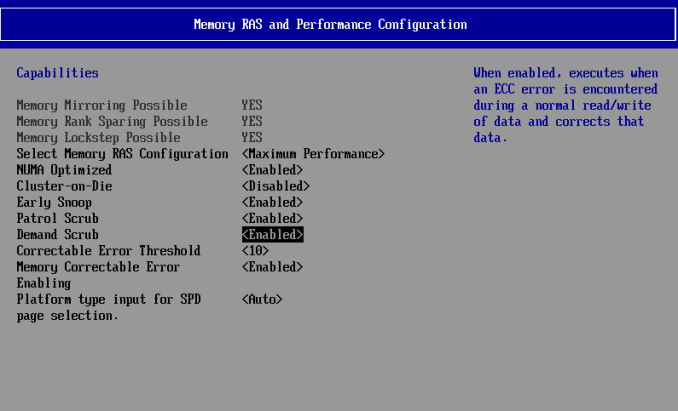The Intel Xeon E5 v4 Review: Testing Broadwell-EP With Demanding Server Workloads
by Johan De Gelas on March 31, 2016 12:30 PM EST- Posted in
- CPUs
- Intel
- Xeon
- Enterprise
- Enterprise CPUs
- Broadwell
Broadwell-EP: A 10,000 Foot View
What are the building blocks of a 22-core Xeon? The short answer: 24 cores, 2.5 MB L3-cache per core, 2 rings connected by 2 bridges (s-boxes) and several PCIe/QPI/home "agents".
The fact that only 22 of those 24 cores are activated in the top Xeon E5 SKU is purely a product differentiation decision. The 18 core Xeon E5 v3 used exactly the same die as the Xeon E7, and this has not changed in the new "Broadwell" generation.
The largest die (+/- 454 mm²), highest core (HCC) count SKUs still work with a two ring configuration connected by two bridges. The rings move data in opposite directions (clockwise/counter-clockwise) in order to reduce latency by allowing data to take the shortest path to the destination. The blue points indicate where data can jump onto the ring buses. Physical addresses are evenly distributed over the different cache slices (each 2.5 MB) to make sure that L3-cache accesses are also distributed, as a "hotspot" on one L3-cache slice would lower performance significantly. The L3-cache latency is rather variable: if the core is lucky enough to find the data in its own cache slice, only one extra cycle is needed (on top of the normal L1-L2-L3 latency). Getting a cacheline of another slice can cost up to 12 cycles, with an average cost of 6 cycles..
Meanwhile rings and other entities of the uncore work on a separate voltage plane and frequency. Power can be dynamically allocated to these entities, although the uncore parts are limited to 3 GHz.
Just like Haswell-EP, the Broadwell-EP Xeon E5 has three different die configurations. The second configuration supports 12 to 15 cores and is a smaller version (306mm²) of the third die configuration that we described above. These dies still have two memory controllers.
Otherwise the smallest 10 core die uses only one dual ring, two columns of cores, and only one memory controller. However, the memory controller drives 4 channels instead of 2, so there is a very small bandwidth penalty (5-10%) compared to the larger dies (HCC+MCC) with two memory controllers. The smaller die has a smaller L3-cache of course (25 MB max.). As the L3-cache gets smaller, latency is also a bit lower.
Cache Coherency
As the core count goes up, it gets increasingly complex to keep cache coherency. Intel uses the MESIF (Modified, Exclusive, shared, Invalid and Forward) protocol for cache coherency. The Home Agents inside the memory controller and the caching agents inside the L3-cache slice implement the cache coherency. To maintain consistency, a snoop mechanism is necessary. There are now no less than 4 different snoop methods.
The first, Early Snoop, was available starting with Sandy Bridge-EP models. With early snoop, caching agents broadcast snoop requests in the event of an L3-cache miss. Early snoop mode offers low latency, but it generates massive broadcasting traffic. As a result, it is not a good match for high core count dies running bandwidth intensive applications.
The second mode, Home Snoop, was introduced with Ivy Bridge. Cache line requests are no longer broadcasted but forwarded to the home agent in the home node. This adds a bit of latency, but significantly reduces the amount of cache coherency traffic.
Haswell-EP added a third mode, Cluster on Die (CoD). Each home agent has 14 KB directory cache. This directory cache keeps track of the contested cache lines to lower cache-to-cache transfer latencies. In the event of a request, it is checked first, and the directory cache returns a hit, snoops are only sent to indicated (by the directory cache) agents.
On Broadwell-EP, the dice are indeed split along the rings: all cores on one ring are one NUMA node, all other cores on the other ring make the second NUMA node. On Haswell-EP, the split was weirder, with one core of the second ring being a member of the first cluster. On top of that, CoD splits the processor in two NUMA nodes, more or less one node per ring.
The fourth mode, introduced with Broadwell EP, is the "home snoop" method, but improved with the use of the directory cache and yet another refinement called opportunistic snoop broadcast. This mode already starts snoops to the remote socket early and does the read of the memory directory in parallel instead of waiting for the latter to be done. This is the default snoop method on Broadwell EP.
This opportunistic snooping lowers the latency to remote memory.
These snoop modes can be set in the BIOS as you can see above.















112 Comments
View All Comments
Kevin G - Thursday, March 31, 2016 - link
Much like how Apple skipped Haswell-EP, they also skipped a generation of cards from AMD and nVidia. So even if Apple doesn't wait for new GPUs, their is certainly an update on the GPU side.The more interesting possibility would be if Apple were to go with Xeon D in the Mac Pro instead of Broadwell-EP. Apple would need a big PLX chip considering the number of lanes they's want to use but it is possible.
bill.rookard - Thursday, March 31, 2016 - link
Another issue is that they're not under any pressure from any competition to really innovate. I don't even remember the last time I read anything about Opteron servers... let alone something about any NEW Opterons.ComputerGuy2006 - Thursday, March 31, 2016 - link
A sign of things to come for Broadwell-e?Seems like a tricky situation. Because skylake-e will come with a new platform in 2017, while broadwell-e isn't the fastest IPC and there are crazy rumors it will might cost $1500 (lol Intel). We also have Zen later this year that might give good performance with good cost/perf ratio.
extide - Thursday, March 31, 2016 - link
Yeah so Intel only gives us the LCC part for the -E platform, so we will see the 10-core SKU as the top, It will either be $1000, or $1500 ... so yeah not sure how that will end up. Although there will be 8 and 6 core options that should be pretty affordable.Hopefully they do an 8 core part with 28 lanes for under $500, as THAT would be a great deal!
dragonsqrrl - Sunday, April 3, 2016 - link
I'm hoping the 8 core SKU is around $600, the position the x930K traditionally occupies. What makes me a little worried is that there will be 4 SKUs instead of 3 this time (one 10 core, one 8 core, and two 6 core), and I'm not sure there's enough room under the $600 price point for two 6 core processors.jasonelmore - Thursday, March 31, 2016 - link
Can it run Star Citizen?theduckofdeath - Thursday, March 31, 2016 - link
A question we'll never get an answer to? :DJohanAnandtech - Friday, April 1, 2016 - link
It probably runs mostly on Xeons. Well, the back end that is :-)extide - Thursday, March 31, 2016 - link
BOOM, 454mm^2 on the worlds best process. The "other" 14/16nm processes use bigger geometry than Intel's 14nm process.Now we just need those other guys to catch up so we can see 450+mm GPU's!
Kevin G - Thursday, March 31, 2016 - link
Intel still has plenty of room to increase die size. The largest chip they've produced was the Tukwila Itanium 2 at 699 mm^2. Granted that was a 65 nm design but Haswell-EX is a juggarnaught at 662 mm^2 on Intel's more recent 22 nm process. Seems reasonable that SkyLake-EX could go to 32 cores as Intel has >200 mm^2 of rectal limit left.As for GPU's, they're also huge. nVidia's GM200 is 601 mm^2 and AMD's Fiji is 'only' 596 mm^2 both on 28 nm process. TSMC's 20 nm process was skipped so even using the looser 16 nm FinFET, GPU's will see a significant shrink compared to the those high end chips.